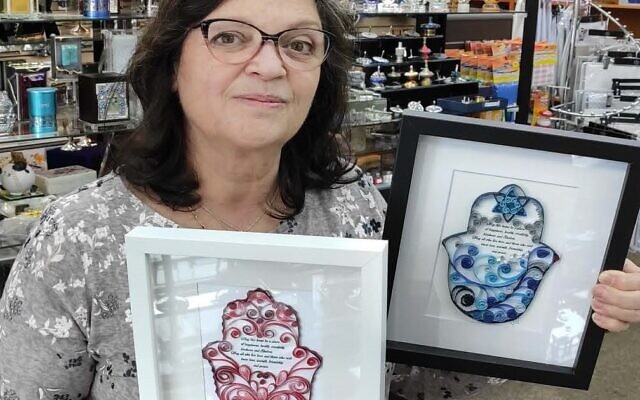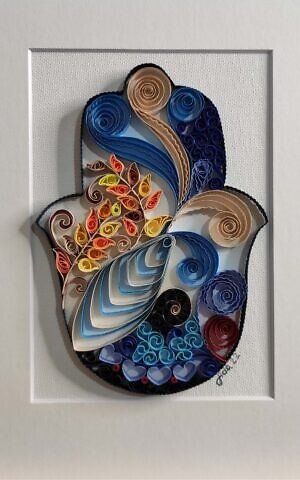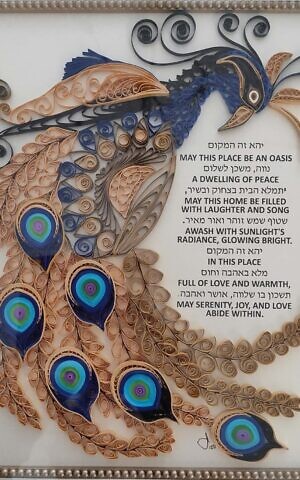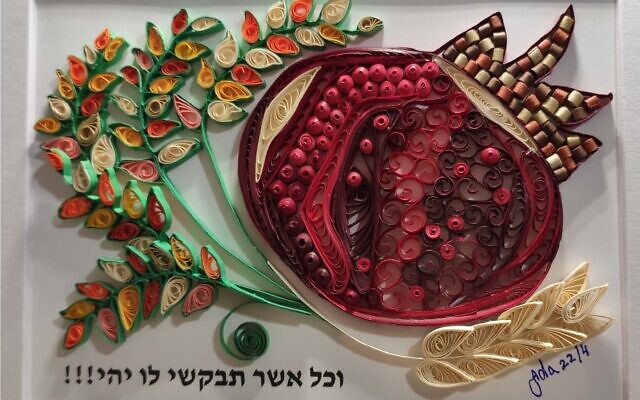The Thrill of Sapir’s Quills
Local Israeli Ada Sapir rolls and curls paper Judaica and pieces with a nod to nature.
After 37 years with the Atlanta Journal-Constitution and now with the AJT, , Jaffe’s focus is lifestyle, art, dining, fashion, and community events with emphasis on Jewish movers and shakers.
Ada Sapir’s intricate, joyful, colorful, and dancing designs bloom with the notions of Judaism and inspirations of nature.
Her quilling, also known as “paper filigree,” starts with envisioning, cutting, turning, folding, and several processes in between. Strips of paper are rolled, curled, twisted, looped, shaped, and glued together, or otherwise manipulated, to create shapes that make up engaging and original designs.
Sapir explained, “I have never had formal art education. My love of creating fueled all my many self-taught forms of art, and still, I continue to grow and learn new skills and improve my techniques. I started quilling 15 years ago just for family and friends and truly found my calling. When the pandemic started, I was encouraged by my daughter-in-law to try and sell my work and it has been a dream come true.”

Paper quilling dates to the 15th century, though some historians believe that it originated in ancient Egypt. It was widely practiced in 18th century France, Italy, and England by women from both nobility and the working class. Others believe it originated in China following the invention of paper. Papers were often used from gilded edges of books. It was popular as a niche craft in the 1970s and ’80s and appears to be making a comeback. Sapir is riding the wave of this re-creation.
Born in Argentina, Sapir attended Jewish day school and art school. At age 10, she sold her first piece, a beaded handbag, to a local boutique. At 12, her family moved to Israel where she lived on a kibbutz and served in the Israel Defense Force. She married and moved with her husband to a moshav (farm), where she grew organic vegetables, considered pioneering at the time, and flowers. Later, in 1991, she followed family to New York, then Florida, until she ultimately moved to Atlanta to be closer to grandchildren.
Sapir explained, “Sometimes, I draw the vision that I have in my mind for a particular piece; often I make pieces then move them around on the canvas for days, until I’m satisfied.”

There are many different ways to curl paper for each piece using tools like combs, rulers, needles and her fingers. Some pieces are glued together, or to each other, and then transferred to the cardboard or canvas. Then, there are pieces that are individually glued directly to the final canvas. She continued, “I often start with an idea in my mind, and then let it evolve, until it feels complete in my mind.”
She is especially inspired by nature and Judaism – two things that greatly impacted her growing up. Into her productions, whether a blessing, a greeting or a good wish, she infuses things that are meaningful and cohesively align to her style.
She concluded, “I also believe that since doing this brings me so much joy, that joy gets infused into each of my pieces.”
Depending on the size and the complexity, it takes between three to 10 days to complete a piece. Sapir employs blessings, passages, stories from the Bible, Hebrew songs, prayers, holidays, and Judaic symbols. Since nature is such an integral part of Judaism, she uses the Seven Species, especially pomegranates, but also depicts doves, other birds, flowers, and items that are associated with sky and water. She uses paper of different weights that are either self-cut or pre-cut.

Quilling is done with text weight paper, which is heavier than printer paper, and sometimes placed on card stock. Her pieces are framed in 8×10” or 11×14”. The prices generally range from $110 to $300. Shipping is included.
Ada has commissioned pieces for Temple B’nai Torah in Wantagh, N.Y., and the Brevard Hadassah Chapter in Florida. Locally, her work is for sale in Judaica Corner on Briarcliff Road. She also takes individual commissions and is willing to interpret all sorts of ideas. Sapir doesn’t paint, but beads, knits and crochets small toys called “amigurumi.”
What’s next for Sapir? Mastering calligraphy by her own hand, in Hebrew and English, to produce quilled ketubahs and blessings. Find Sapir on Etsy at www.etsy.com/shop/AdaStudioDesigns; on Instagram: @adastudiodesigns; and her website at adastudiodesigns.wixsite.com/website




comments